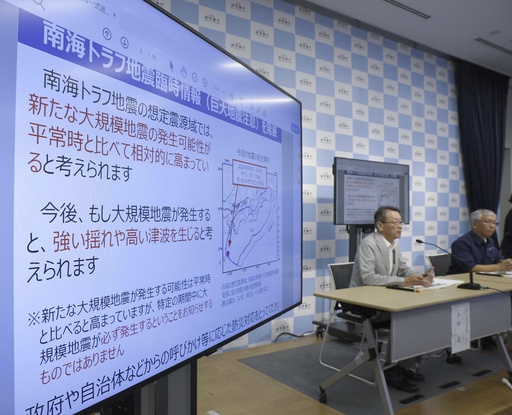
Japan, a country prone to earthquakes, recently issued its inaugural “megaquake advisory” after a significant earthquake struck off the southeastern coast of Kyushu’s main island. The earthquake, with a magnitude of 7.1, fortunately caused no casualties or severe damage, but the advisory has caused uncertainty and anxiety in a nation familiar with regular seismic activity, as concerns grow about the timing of a potential large earthquake.
The Japan Meteorological Agency (JMA) issued the advisory after determining that the recent 7.1 quake near the Nankai Trough raised the likelihood of another major earthquake. An estimated 70-80% chance exists of a magnitude 8 or 9 quake originating from the Nankai Trough within the next three decades, with the chances heightened following the recent quake, according to the JMA’s assessment.
The Nankai Trough, a trench beneath the ocean that stretches from Hyuganada near Kyushu to Suruga Bay in central Japan, poses a significant risk. The trench spans approximately 800 kilometers (500 miles) along the Pacific coast, where the movement of the Philippine Sea Plate against the Eurasian Plate creates the potential for a megaquake and ensuing tsunami, as previously seen in the devastating 1946 Nankai Trough quake that claimed over 1,300 lives.
Considering the potential impact, a government study in 2013 warned that a magnitude 9.1 Nankai Trough quake could trigger a tsunami over 10 meters (33 feet) high within minutes, resulting in a profound loss of life, destruction of buildings, and extensive economic damage to Japan’s coastal regions.
In response to the “megaquake advisory,” Prime Minister Fumio Kishida canceled his Central Asia trip to oversee the government’s response and ensure adequate preparedness and public communication. Municipalities at risk from a Nankai Trough quake were advised by the Fire and Disaster Management Agency to review their emergency measures and evacuation plans. Experts and officials urged the public to stay calm, continue daily activities, stock emergency supplies, and discuss evacuation strategies with family members.
The issuance of the advisory caused concern and confusion among the populace, with some towns canceling events and closing beaches, impacting travelers during Japan’s Obon holiday week. Citizens rushed to buy emergency supplies, leading to shortages at supermarkets. While many struggled to grasp the implications of the advisory, there were efforts to maintain a balance between preparedness and normalcy.
Affected regions, such as Matsuyama city and the coastal town of Kuroshio, reviewed evacuation procedures and made preparations in case of emergency. Rail companies implemented precautionary measures, and local governments advised residents to refrain from non-essential travel during seismic risks. Despite the uncertainty, efforts were made to ensure safety and readiness in the face of potential disaster in Japan.
